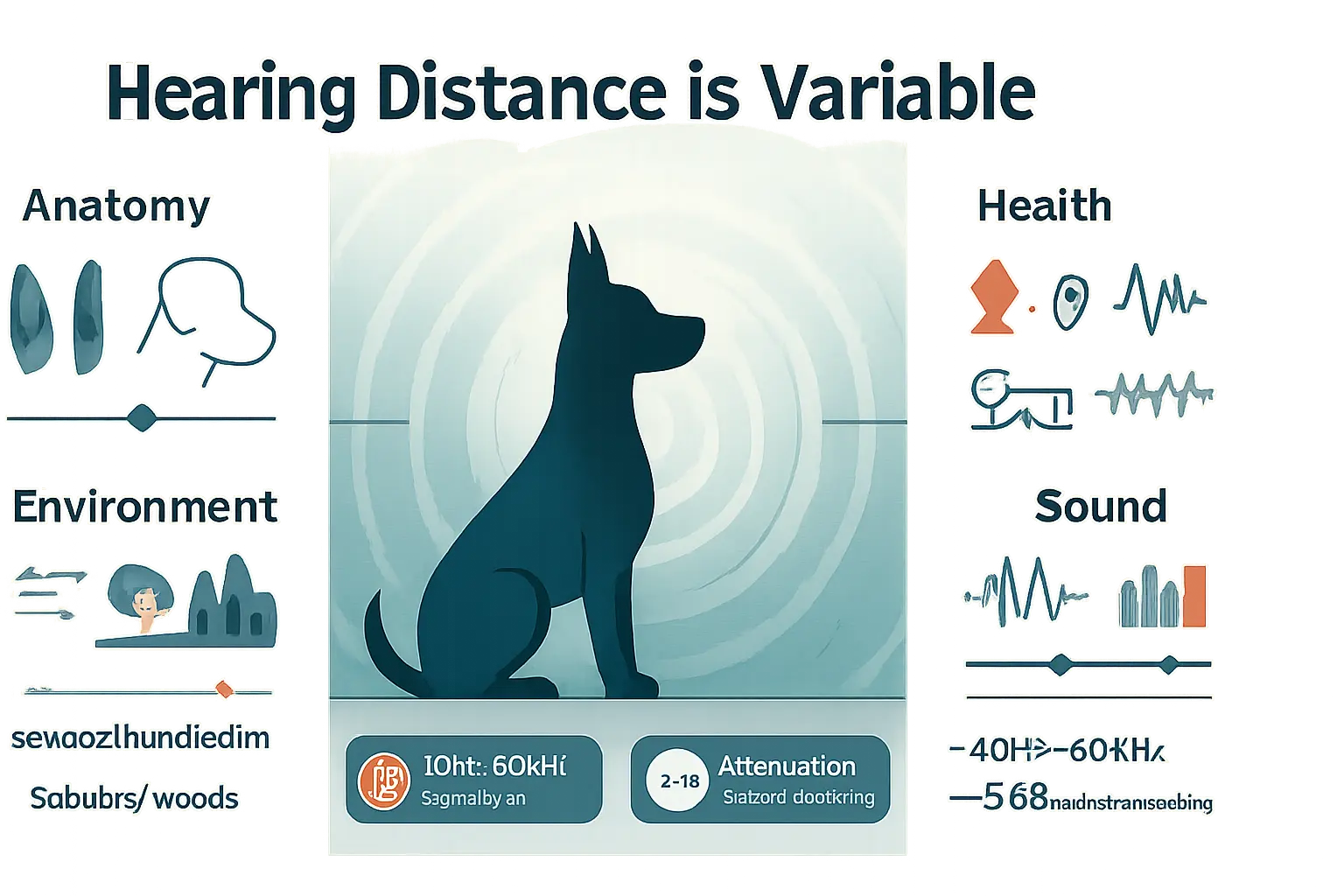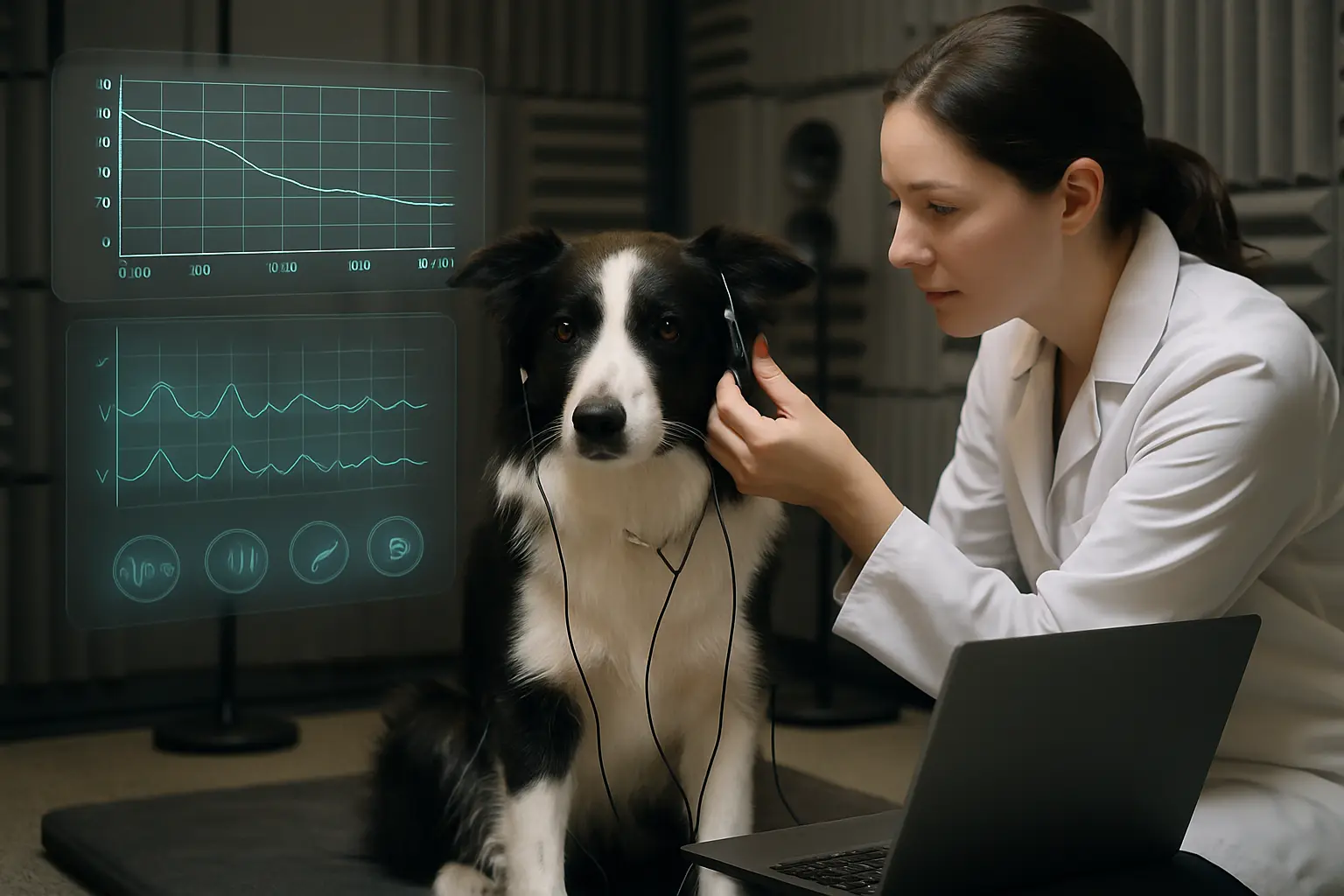How Far Can Dogs Hear? Distance, Frequency & What Affects Canine Hearing
Last Updated on September 13, 2025
How Far Can Dogs Hear? It depends on distance, frequency, and environment. Dogs detect higher frequencies and softer sounds than humans. Yet “distance” is not a fixed number. Sound weakens with range and background noise. Wind, terrain, and obstacles reshape what reaches a dog’s ears. Breed, ear shape, age, and ear health also change real‑world hearing.
This guide unpacks Distance, Frequency & What Affects Canine Hearing with practical detail. It covers frequency bandwidth in hertz and decibel sensitivity. It explains ear anatomy, localization, and the “four times farther” claim. Expect realistic ranges for whistles, voices, footsteps, thunder, and sirens. It shows how veterinarians measure hearing with BAER and behavioral tests. It flags early signs of loss and simple protection steps. Readers can choose better cues, plan training, and reduce noise stress.
What are a dog’s hearing limits?
Dogs hear a broader band of sound than humans and detect fainter noises. Typical adult dogs pick up frequencies well above the human upper limit, and their mobile outer ears help capture and funnel sound. Age, breed, ear shape and prior ear disease all change a dog’s effective hearing limits. Environmental factors — wind, background noise and barriers — also alter what a dog actually detects at any moment. Veterinary testing such as a BAER (brainstem auditory evoked response) gives an objective measure of neural hearing, while behavioral tests show what the dog uses in daily life. Owners should note that travel and altitude changes can affect ear comfort and perception; see does flying hurt dogs’ ears? for discussion of pressure, discomfort and travel-related ear issues. When hearing concerns arise, a veterinarian can guide testing and management. A clear baseline observation—responses to calls, toys and household noises—helps spot gradual decline without confusing temporary ear pain with sensory loss.
Frequency bandwidth in hertz (typical dog vs human ranges)
Most dogs hear frequencies humans cannot. Humans typically detect about 20 Hz–20,000 Hz. Dogs commonly hear from roughly 40 Hz up to 60,000 Hz or higher, depending on the source. That extended high end explains responses to dog whistles and ultrasonic training devices. Higher frequencies give dogs fine detail for short-range sounds, like rustling in leaves or high-pitched squeaks. Breed anatomy modifies this bandwidth: erect, funnel-shaped ears improve high-frequency capture and localization. Puppies show broader sensitivity than elderly dogs, which often lose high-frequency hearing first. Audiometric testing maps a dog’s threshold across the spectrum to reveal which bands remain functional. For owners who worry about loud or unfamiliar high tones—such as at the beach or during water activities—products designed to reduce high-frequency exposure can help; see guidance on dog ear plugs for swimming for context on protecting sensitive ears during activities.
Loudness sensitivity in decibels and what quiet sounds dogs detect
Dogs identify quieter sounds than many humans notice, especially at higher frequencies. Everyday sound references help: a whisper sits around 20–30 dB, normal conversation near 60 dB, and a barking dog often reaches 80–100 dB. Dogs will often react to rustling, insect buzzes and distant footsteps that register only tens of decibels. Sensitivity varies by frequency; a high-frequency squeak at low decibels may trigger attention more readily than a low-frequency hum at the same level. Signs a dog struggles with hearing include failing to respond to common cues, startling easily at close noises, or relying more on visual signals. Prolonged exposure to loud sounds—fireworks, concerts or engine noise—can damage canine hearing. Owners should limit duration near loud sources and seek veterinary advice if they observe persistent behavioral changes. For travel-related whining or stress linked to sound, see the practical notes on dog whining on plane.
Why “distance” is not a fixed number — how sound intensity falls with range
Distance alone does not determine whether a dog hears a sound. Sound intensity drops roughly 6 dB each time distance doubles in open air, but real-world conditions alter that rule. Obstacles, ground reflections, temperature layers and wind all change attenuation. Low-frequency sounds travel farther with less loss; high frequencies suffer greater absorption and scattering. Background noise level also sets an effective hearing limit: a faint noise that stands out in quiet countryside will vanish inside a busy street. Measurement requires controlled tones and calibrated equipment, or behavioral trials that record the farthest distance at which a dog reliably responds. Practical examples: dogs often detect distant vehicles, wildlife calls or other dogs across fields, yet fail to hear a high-pitched household beep behind a wall. Owners assessing hearing should test in multiple environments. If hearing seems inconsistent across settings, consult a veterinarian to rule out conductive issues, ear infections or age-related decline. For behavioral responses to environmental noise during transport, see why do dogs cry in the car?.
How a dog’s ear and brain amplify distant sounds
The ear and brain act together like a finely tuned amplification system. The outer ear collects and funnels sound waves down the ear canal. The tympanic membrane converts those waves into mechanical motion. Tiny middle ear bones, the ossicles, then boost that motion before it reaches the inner ear. Neural pathways in the brain further increase sensitivity by filtering noise and enhancing weak, behaviorally important signals.
Amplitude gains come from mechanical advantages and active biological amplification. The ossicles serve a lever function and reduce the impedance mismatch between air and fluid. Outer hair cells in the cochlea add active amplification at specific frequencies, increasing the amplitude of faint, high‑frequency sounds. That combination lets dogs detect distant or subtle cues that humans miss.
Environmental noise strongly affects how far a dog can hear. In quiet, a dog can detect faint sounds four times farther than a typical human under similar conditions. In noisy settings, amplification helps but does not overcome all masking. For travel-related pressure and noise issues, owners can read practical advice about Does flying hurt dogs’ ears? This resource helps connect anatomical sensitivity with real-world travel concerns.
Outer, middle and inner ear roles in capturing sound
The outer ear focuses sound; the middle ear transmits and amplifies it; the inner ear transduces and encodes it. The pinna collects sound and boosts certain frequencies by shaping and channeling waves into the canal. That resonance improves detection of faint, high-frequency sounds used in play or alarm calls.
The tympanic membrane converts air pressure fluctuations to mechanical motion. The ossicles (malleus, incus, stapes) amplify motion and concentrate it onto the oval window. That concentration raises pressure at the fluid interface of the cochlea, improving energy transfer into the inner ear.
Inside the cochlea, the basilar membrane separates frequencies along its length. Outer hair cells sharpen frequency selectivity and provide active gain. Inner hair cells convert vibrations into neural spikes that travel along the auditory nerve. Because of this chain, damage at any stage reduces range or clarity. For owners concerned about water or infection risks, simple protective options appear in posts like Dog ear plugs for swimming.
Mobile earflaps and sound‑localization mechanics
Mobile earflaps give dogs a directional advantage. The pinnae swivel to capture sound more from one side. That movement enhances interaural level differences (ILDs) and interaural time differences (ITDs), two cues the brain uses to compute sound direction. Small head size limits ITD for low frequencies, but high frequencies yield strong ILDs because the head casts a sound shadow.
Pinna shape also creates spectral cues. Sound reflections and notches introduced by the ear’s contours allow the brain to estimate elevation. Quick head tilts and ear adjustments refine localization in milliseconds. These mechanics let a dog pinpoint a rustle, distant whistle, or moving vehicle even when the source hides behind obstacles.
Localization plays a practical role during travel and vehicle rides. Sudden external noises often trigger searching and stress, which relate to how dogs orient to sound in cars. Owners can learn calming and safety techniques in posts such as Why do dogs cry in the car?
Cochlea, hair cells and neural processing of high frequencies
The cochlea translates mechanical motion into precise neural codes. Its spiral layout maps high frequencies near the base and low frequencies near the apex. Outer hair cells act as electro-mechanical amplifiers; they expand and contract to boost basilar membrane motion at tuned frequencies. Inner hair cells then release neurotransmitters to excite auditory nerve fibers.
This mechanical-to-neural transduction gives dogs superior sensitivity to high frequencies. The auditory nerve conveys timing and rate information to the brainstem. Brainstem nuclei compute interaural cues, while cortical areas analyze patterns and link sound to memory and behavior. That pathway supports rapid detection and prioritization of biologically relevant sounds.
Loud noises, chronic ear infections, and aging can damage hair cells and reduce high-frequency sensitivity. Early signs of hearing loss include failure to respond to distant cues or unilateral inattention. If owners suspect hearing decline, a veterinary exam provides diagnostic tests and management options. For concerns about travel-related vocalization and stress at altitude, see Dog whining on plane.
Key factors that change how far an individual dog hears

Several interacting factors determine how far a dog detects sound. Anatomy sets a baseline: ear shape, canal length and skull geometry change sensitivity and directionality. Age and ear health alter thresholds over time; chronic infections or wax reduce range. Environmental conditions change propagation—wind, humidity, and background noise can cut effective distance dramatically. Sound characteristics matter too: frequency, duration and loudness control how quickly a signal fades with distance.
Under calm, quiet conditions, many dogs detect sounds at distances far beyond human ability. High-frequency noises stand out but attenuate sooner than low-frequency tones. Loud, low-frequency events travel farther; faint, high-pitched rustles need closer proximity. Measurement varies by method, but practical hearing range depends less on a fixed number and more on the mix of anatomy, health, environment and the sound itself. For real-world context on ear pressure and travel situations that affect hearing, see does flying hurt dogs’ ears.
Breed, ear shape and head anatomy
Breed-specific traits produce predictable hearing differences. Dogs with erect, mobile pinnas—like many herding breeds—capture and funnel sound more efficiently. Floppy-eared breeds reduce directional cues and can trap moisture, which raises infection risk and affects hearing.
Skull shape matters. Dolichocephalic heads often provide better sound localization than very short, flat faces. Ear-canal length and the angle between ears change how well a dog pinpoints distance and bearing.
Breeders and owners should note that selective breeding for appearance sometimes reduces functional traits. Choosing a breed for activities that demand acute hearing means favoring erect ears and clean ear conformation. For practical comparisons among breeds and travel-friendly sizes, review resources on dog breeds that fit under airplane seat, which list common breed shapes and ear types.
Age, ear health and genetic deafness risks (coat‑color links)
Hearing declines with age through presbycusis, a gradual loss of high-frequency sensitivity. Chronic otitis externa, ruptured eardrums and wax impaction reduce detection distance at any age. Regular ear checks and prompt treatment preserve range.
Genetics also plays a role. Certain coat-color genes link to congenital deafness. Breeds with extensive white spotting or the merle pattern—such as Dalmatians and some Australian Shepherd lines—show higher congenital deafness rates. Puppies sometimes fail newborn hearing screens; breeders use BAER testing to confirm.
Owners who suspect loss should seek veterinary evaluation. A vet can recommend cleaning routines, medical treatment or diagnostic testing. For ear-care products and protective options used during water activities, consider advice from guides like dog ear plugs for swimming.
Environmental influences: weather, background noise and terrain
Environment changes how sound travels and how a dog perceives distance. Wind disperses and masks directional cues. In strong wind, high frequencies scatter and lose clarity, reducing detectable range. Temperature gradients also bend sound waves, sometimes carrying noise farther at night.
Background noise creates masking. Urban traffic, trains or running water raise the detection threshold; faint signals drop below audibility. Terrain affects both propagation and reflection. Open fields allow longer-range hearing because fewer obstacles interrupt waves. Dense forest or built environments cause absorption and echoes that confuse localization and shorten effective distance.
Training and situational awareness help. In noisy or variable terrain, owners should use visual cues and shorter recall distances. For tips about noisy transport environments and how they affect a dog, see traveling with your dog by train: tips and tricks.
Sound properties: frequency, duration and loudness
Sound physics drives how distance affects audibility. Frequency matters: dogs detect frequencies up to roughly 40–65 kHz, well above human range. Higher frequencies carry detail but attenuate quickly; they lose energy faster over distance than low frequencies.
Duration influences detectability. Longer sounds provide more energy and time for the ear to register them. Very short, impulsive noises can still trigger attention if they contain strong high- or low-frequency components. Loudness (decibels) sets a signal’s starting strength; louder sounds remain audible farther away.
Directionality and spectral content aid localization. Dogs use interaural time and level differences across frequencies to estimate distance. Low-frequency energy travels farther but gives poorer localization; high-frequency cues provide precise bearing but require closer range. Understanding these trade-offs helps owners choose signals—like whistles or voice cues—that match distance and environment. For insight into on-board noise and how dog vocalizations behave in enclosed spaces, consult what happens if my dog barks on a plane.
Interpreting real‑world hearing: distances for common sounds
Estimating how far a dog can hear requires moving beyond laboratory thresholds. Laboratory measures report frequency sensitivity and quiet‑room thresholds. Real environments add wind, terrain, vegetation, and background noise. Dogs detect higher frequencies and softer sounds than humans. Breed, ear shape and age change sensitivity too. A young, erect‑eared dog with no ear disease hears best at high frequencies and low amplitudes.
Distance estimates must consider sound pressure level, frequency and frequency‑dependent attenuation. High frequencies attenuate faster outdoors. Low frequencies travel farther but may fall below a dog’s peak sensitivity. Ambient noise often masks distant sounds that dogs would detect in isolation. Observers should interpret dog responses as directional clues, not precise range measurements.
When planning travel or outdoor activity, managers can reduce noise and control approach distances to avoid startling dogs. For practical travel advice on reducing noise stress and managing canine responses on the road, see essential dog travel tips and gear for road trips.
Typical detection ranges for whistles, human voices and footsteps
Dogs detect whistles differently than human speech because whistles concentrate sound at high frequencies. A handheld dog whistle emitting high kHz tones can be audible to a dog at several hundred meters in quiet, open terrain. In suburban or wooded areas that range often shrinks to tens of meters.
Human conversation centers on mid frequencies. A dog often notices a raised human voice or shout at 50–200 meters in quiet settings. Normal, quiet conversation usually alerts dogs at shorter distances, especially with wind or background noise.
Footsteps produce broad spectra with strong low frequencies. Low frequencies travel farther but attract less attention than sudden high‑pitched noises. A dog may hear a distant walker before seeing them, but detection distance varies from a few meters in dense brush to over a hundred meters on open ground.
Owners using whistles or recall cues should test them in the actual environment. For gear that reduces unwanted noise exposure, review options like dog ear plugs for swimming, which also illustrate how protection changes perceived sound levels.
How far dogs hear thunder, sirens and wildlife sounds
Thunder often contains strong, low‑frequency energy that travels long distances. Dogs may react to thunder many kilometers away, depending on storm size and atmospheric conditions. However, distant thunder can lack the high‑frequency components that grab a dog’s attention.
Sirens emit high amplitude, often sweeping frequencies. Their loudness makes them detectable at substantial distances in urban areas despite competing noise. Direction and reflective surfaces in cities change how far and where dogs pick up sirens.
Wildlife sounds vary by species. Small mammals and birds produce high frequencies that dogs excel at hearing. In quiet woodland, a dog might detect rustling or a nearby squirrel tens to a few hundred meters away. Dense foliage shortens those ranges dramatically.
Because loud environmental sounds can trigger anxiety, handlers should apply calming strategies and desensitization techniques. Practical approaches to noise sensitivity are available in resources on natural anxiety remedies, for example natural ways to remedy a dog’s travel anxiety.
Origin and limits of the “four times farther” claim — practical context
The claim that dogs hear “four times farther” than humans stems from comparing sensitivity thresholds. Dogs typically detect higher frequencies and lower amplitudes. Translating sensitivity differences into distance requires careful physics. Sound level drops with distance, and a fixed dB advantage does not convert linearly to distance across environments.
Under ideal, quiet, open conditions, a canine advantage of 12–24 dB at certain frequencies could let a dog detect a source several times farther than a human listener. Real landscapes, background noise and frequency‑dependent absorption reduce that multiplier. In urban or wooded settings, the practical distance advantage often falls short of the neat “four times” rule.
Handlers should treat the claim as a rough heuristic, not a dependable measurement. Use behavioral observation and context to judge what a dog actually perceives. For physiology‑focused information about ear sensitivity and pressure effects, consult discussions such as does flying hurt dogs’ ears.
How veterinarians and scientists measure canine hearing

Veterinarians and researchers use complementary methods to map what dogs hear and how well they hear it. They combine behavioral tests, objective electrophysiology, and careful acoustic controls. Behavioral tests show what a conscious dog detects and responds to. Electrophysiological tests, like BAER, record brain activity to sounds. Together these approaches reveal frequency range, sensitivity, and neural integrity.
Measurements focus on two outputs: frequency sensitivity (how high and low a dog detects) and amplitude threshold (the quietest sound a dog hears at each frequency). Clinicians translate those outputs into practical findings, such as whether a dog can respond to a whistle or will miss soft vocal cues.
Environmental controls matter. Tests occur in quiet rooms or sound booths to remove background noise and echoes. Technicians calibrate speakers and use reference-level tones so results are comparable across labs. For owners curious about ear pressure and noise effects during travel, see Does flying hurt dogs’ ears? for practical context on how pressure and noise change auditory perception.
When reading results, veterinarians prioritize objective data first, then interpret how behavioral performance aligns with those findings. A measured hearing deficit on an electrophysiology test carries different implications than a dog that simply ignores a sound because of distraction or anxiety.
Behavioral testing and conditioned‑response methods
Behavioral testing measures a dog’s detectable sounds by observing trained responses. Technicians use conditioning: the dog learns to perform a response when it detects a tone. Common responses include touching a target, pressing a lever, or looking at the sound source. Trials present tones at varying frequencies and intensities while the tester records hits, misses, and false alarms.
Advantages include direct information about what a conscious dog will actually notice in daily life. The method reveals how motivation, training, and distraction change detection. Limitations include subjectivity and variability. A bored or anxious dog can underperform, producing an apparent hearing loss that reflects behavior, not true auditory sensitivity.
To reduce behavior-related artifacts, testers reward quick, consistent responses and run enough trials to estimate a threshold statistically. Trainers who work on noise reactivity or separation distress often use similar conditioning principles; see techniques in 9 natural ways to remedy your dog’s travel anxiety for related behavior approaches.
BAER (brainstem auditory evoked response) and audiograms explained
BAER testing records electrical responses from the brainstem after brief sounds. The test uses surface electrodes and clicks or tone bursts. BAER provides an objective measure of neural transmission time and gross hearing ability. It detects unilateral vs bilateral deficits and can indicate nerve or brainstem pathology.
Audiograms plot hearing threshold versus frequency. Clinicians derive them from either behavioral thresholds or electrophysiological thresholds (using frequency‑specific stimuli). Audiograms show which frequencies a dog hears best and where sensitivity drops. Dogs typically detect much higher frequencies than humans do; an audiogram makes that clear by extending well above human limits.
BAER and audiograms complement each other. BAER is best for noncooperative patients and neurologic diagnosis. Behavioral audiograms best reflect functional hearing. For owners thinking about protecting sensitive ears during swimming or noisy environments, practical products and fitting tips appear in resources like dog ear plugs for swimming.
Why distance‑only tests are misleading and how to read results
Distance-only claims—like “a dog heard a faint noise 500 meters away”—sound clear but mislead. Sound level falls quickly with distance, and environment, frequency, and background noise change detectability dramatically. High frequencies attenuate faster in air and by obstacles than low frequencies. Wind, temperature gradients, and surface reflections also alter how far a tone travels.
Tests that report only distance omit critical details: the sound source level (dB), frequency content, measurement environment, and the dog’s attention state. A loud whistle at 16 kHz may be heard at long range in open terrain but not in a noisy suburban street. Conversely, low-frequency noises carry farther through foliage and buildings.
To read results use these checkpoints:
- Check frequency and decibel level used for the test.
- Note testing environment: open field, urban street, or sound booth.
- Confirm whether results came from behavioral thresholds or objective BAER measures.
- Consider the dog’s breed, age, and ear anatomy.
When owners see distance claims, they should ask for frequency and level data. That context turns a vague distance into actionable information about whether a dog will notice a real-world sound. For related behavioral signs of distress from noise while traveling, see why dogs cry in the car.
Recognizing hearing loss and what to do about it
Hearing loss in dogs develops gradually or appears suddenly. Owners often miss early changes because dogs rely heavily on smell and sight. Common causes include chronic ear infections, noise exposure, age-related degeneration, trauma and certain medications. A veterinarian can determine whether the loss is conductive (ear canal or eardrum problems) or sensorineural (inner ear or nerve damage). Treatment depends on the cause: infections and foreign bodies respond to medication or cleaning, while sensorineural loss may be permanent.
When hearing loss shows in behavior, act promptly. Sudden deafness requires urgent veterinary attention; infections or ruptured eardrums can worsen without care. For gradual loss, create a plan that covers diagnosis, safety and training adjustments. Owners who travel with dogs should note that ear problems sometimes relate to pressure or inflammation from flights — see Does flying hurt dogs’ ears? for factors that affect canine ear health during travel. A clear diagnosis helps select the right combination of medical treatment, rehabilitation and environmental changes.
Early signs your dog may be losing hearing
Behavioral clues often precede obvious problems. The most reliable early signs are reduced response to previously learned verbal cues and altered play habits. If a dog stops retrieving or appears uninterested in noisy toys, hearing may be a factor. Increased startle when touched, sleeping more deeply despite noise, and failing to notice household sounds all suggest diminished hearing.
Other signals include louder-than-normal barking, which compensates for reduced auditory feedback, and difficulty locating the source of noises. Owners might interpret these changes as stubbornness. Observe whether the dog responds to visual prompts but not voice commands. For real-world examples of behavior changes that can indicate sensory decline, see Why my dog won’t play fetch anymore. Early detection improves outcomes by allowing medical treatment or training adjustments sooner.
At‑home checks and when to seek veterinary testing
Owners can perform simple, noninvasive checks at home. From out of sight, call the dog’s name at normal volume and note any reaction. Try a quiet clap behind the dog and a louder clap from a distance. Drop a treat onto a hard floor to test sound detection. Use visual cues immediately after the sound to separate hearing from attention issues.
Inspect the ears for discharge, odor, redness or swelling. Excessive wax and recurrent head shaking point to chronic otitis externa, which can damage hearing if untreated. If at-home tests show reduced responses or if the dog shows puzzling behaviors like disorientation, arrange a veterinary exam. A vet may recommend otoscopic inspection, cytology and culture, and imaging if needed. For definitive diagnosis of sensorineural loss, ask about a BAER (brainstem auditory evoked response) test. If hearing loss appears overnight or coincides with head tilt, balance problems or facial paralysis, seek urgent veterinary care. For related behavioral cues during travel, consult resources like Why do dogs cry in the car?.
Management options: training, safety adaptations and assistive devices
Management focuses on communication, safety and quality of life. Training shifts from voice to visual and tactile cues. Teach consistent hand signals and use a flashlight or laser pointer for long-range cues. Short vibration collars (not punitive shock devices) help redirect attention and can mark commands when paired with positive reinforcement.
Safety adaptations reduce risk. Keep deaf dogs leashed near roads, secure yards with double gates and add reflective collars for nighttime visibility. For travel, ensure crates or harnesses prevent escape; see travel gear recommendations in Essential dog travel tips and gear for road trips. Clean and medicate ears per veterinary guidance to prevent further damage. Owners can also consider protective options for sensitive ears; products such as dog ear plugs for swimming illustrate how devices reduce water and noise exposure.
Consult a veterinarian and a certified trainer experienced with deaf dogs to build a tailored plan. If ready for next steps, schedule a professional hearing assessment or behavior consultation to confirm diagnosis and start training.
Protecting your dog’s ears and reducing noise stress

Owners who understand How Far Can Dogs Hear? Distance, Frequency & What Affects Canine Hearing can better protect canine hearing and reduce noise stress. Dogs detect higher frequencies and quieter sounds than humans, so common household noise can upset them at greater distances. Create quiet zones, limit exposure to loud sources, and watch for signs of distress such as panting, hiding, or sudden agitation. Use protective products sparingly and under guidance. For water activities, consider specialized options like dog ear plugs for swimming that fit correctly and stay clean. If a dog shows persistent sensitivity or discharge, advise a veterinary exam promptly.
Practical steps for home ear care and injury prevention
Inspect ears weekly for redness, odor, or swelling. Clean only with vet-approved solutions and cotton pads. Never insert cotton swabs into the canal. Dry ears thoroughly after swimming or baths to reduce infection risk. Keep nails trimmed to avoid accidental ear injuries during play. Seek immediate veterinary attention for sudden head tilt, bleeding, or severe pain. Maintain parasite prevention to avoid ear mites and secondary infections.
How to prepare dogs for loud events (fireworks, storms, construction)
Desensitize early by playing recorded noises at low volume and rewarding calm behavior. Increase exposure gradually while offering treats and play. Provide a safe den with familiar bedding and low lighting. Use white noise or soft music to mask sudden sounds. Exercise the dog beforehand to reduce anxiety. For severe cases, consult a veterinarian about short-term medication or professional behavior therapy.
Devices to avoid (ineffective/aversive ultrasonic collars) and safer alternatives
Avoid ultrasonic or aversive collars that emit high-frequency sounds. These devices can cause pain, confusion, and increased anxiety. Evidence of long-term benefit remains weak. Prefer positive-reward training, sound desensitization programs, and physically protective options like padded ear muffs. Consider behavior modification with a certified trainer and discuss supplements or prescription options with a vet. Choose products that state veterinary approval and return policies, and always monitor the dog’s response closely.
Common questions about canine hearing (short answers)
How far dogs hear depends on sound type, volume and environment. A focused, high-pitched noise carries farther to a dog than a low rumble. Dogs detect frequencies roughly between 40 Hz and 60 kHz, so they hear far above human upper limits. Breed and ear shape affect sensitivity and directionality. A working dog with erect ears typically localizes quieter sounds at greater distances than a short-eared companion breed. Pain threshold varies with loudness and frequency; sustained sounds above 120–140 dB can cause pain or damage. Sudden noises at lower levels may startle but not injure. To test hearing safely, use quiet, controlled cues at increasing distances and watch eye and ear orientation, head tilt, or a trained cue response. If responses decline, schedule a veterinary exam. For practical context on protecting canine ears during noisy travel, see does flying hurt dogs’ ears?
Can dogs really hear higher frequencies than humans?
Yes. Dogs sense frequencies humans cannot. Most people hear up to about 20 kHz. Dogs commonly detect sounds up to 45–60 kHz depending on age and breed. That capacity explains why a dog reacts to a dog whistle or a distant high-pitched beep long before a human notices it. The ear’s anatomy contributes: the canine ear canal and more mobile pinnae funnel high-frequency energy efficiently. High frequencies attenuate faster over distance than low ones, so dogs need closer proximity to hear very high-pitched tones clearly. Age and ear health lower the top detectable frequency; older dogs often lose high-frequency sensitivity first. Environmental noise further masks high tones. Practical takeaway: high-frequency alarms and ultrasonic devices register to most dogs but not uniformly to every individual. For guidance on ear protection during noisy situations, owners may refer to resources about dog ear plugs for swimming, which discuss ear safety and comfort in different environments.
Do all breeds hear the same distance?
No. Hearing distance varies by breed, ear shape, skull size, and individual training. Erect, mobile ears and a longer ear canal often improve sound capture and localization. Breeds developed for hunting or herding tend to have finer auditory acuity for faint or distant cues. Brachycephalic breeds and dogs with heavy, pendulous ears can experience slightly reduced directional hearing and attenuation of faint sounds. Body size and head shape change the effective distance a sound must travel to reach the inner ear at detectable strength. Behavior and attention matter too: a distracted dog ignores distant sounds that a focused dog will catch. Measured distance also depends on the sound’s frequency and amplitude; a low-frequency freight-train rumble travels farther than a short, high-frequency chirp. For practical breed considerations when planning travel or public transport, consult breed-size and travel advice such as lists of dog breeds that fit under airplane seat, which help owners match a dog’s needs to situations where hearing and stress matter.
How close must a sound be for a dog to ignore it or be in pain?
Ignore and pain thresholds differ by dog and sound. A dog may ignore faint noises below its detection threshold—often tens to hundreds of meters for loud, low-frequency sounds in quiet conditions. High-frequency, low-amplitude signals need much closer proximity. Pain and immediate ear damage occur at very high sound pressure levels, commonly above 120 dB. Examples include close exposure to sirens, fireworks, or very loud machinery. Sudden impulse noises can be painful at lower levels than continuous sounds. Distance matters: a firecracker that causes pain at two meters might be harmless at thirty meters. Acoustic environment also changes impact—hard surfaces and confined spaces amplify loud sounds. Owners should avoid placing dogs near loud events and use protective strategies when travel or unavoidable noise occurs. If a dog shows signs of ear pain—head shaking, yelping, or ear rubbing—seek veterinary care. More on noise-related ear concerns during travel appears in coverage about does flying hurt dogs’ ears?
Simple tips to test your dog’s hearing safely at home
Use quiet, controlled steps and no sudden loud noises. Start with a familiar cue—name call, food bag rustle or a soft whistle—while the dog faces away. Increase distance gradually and record consistent responses: head turn, ear prick, or movement toward the source. Test different frequencies and volumes: speak in low, normal, and high pitches, and use a soft high-pitched noise like a whistle at low volume. Avoid loud devices and fireworks substitutes. Test each ear by presenting sound to one side from about three to five meters and noting asymmetry in response. Repeat across days to avoid false negatives caused by distraction or fatigue. Keep sessions brief and positive; reward correct responses. If responses weaken, especially suddenly, book a veterinary exam for ear infection or hearing evaluation. For practical travel preparedness and gear that helps calm and monitor dogs, see tips in essential dog travel tips and gear for road trips.
Summary
How Far Can Dogs Hear? Distance, Frequency & What Affects Canine Hearing explains that dogs detect a wider frequency band and softer sounds than humans, but “how far” they hear is never a fixed number. Distance depends on loudness, frequency, background noise, wind, obstacles, terrain, and the dog’s anatomy and health. High frequencies provide detail but fade faster; low frequencies travel farther but are less precise for localization.
The post outlines practical ranges for common sounds, clarifies the limits of the “four times farther” claim, and shows how professionals measure hearing with behavioral tests and BAER. It closes with early signs of hearing loss, at‑home checks, and protective strategies so owners can preserve hearing, adapt communication, and seek timely veterinary care.
Key Takeaways
- Frequency range: Most dogs hear roughly 40 Hz to 60 kHz; puppies are most sensitive, and age-related loss typically starts at high frequencies.
- Distance is contextual: Sound drops ~6 dB each time distance doubles; in quiet, open areas a whistle can carry several hundred meters, while urban or wooded settings cut ranges to tens of meters.
- Anatomy and health: Erect, mobile ears and healthy canals improve sensitivity; infections, wax, ear shape, genetics, and aging reduce effective range.
- Environment and sound properties: Wind, terrain, and background noise create masking; high frequencies attenuate faster than lows, and longer or louder signals carry farther.
- Measurement matters: Combine behavioral thresholds with BAER for objective data; distrust distance-only claims without frequency, decibel level, and test conditions.
- Protection and management: Limit loud exposure, create quiet zones, use vet-approved ear care, and switch to visual/vibration cues if hearing declines.
FAQ
- What frequencies can dogs hear compared with humans?
Dogs typically detect about 40 Hz–60 kHz, while most humans top out near 20 kHz. Breed, age, and ear health shift the upper limit, with seniors often losing high-frequency sensitivity first. - How far can a dog hear a whistle or a voice?
In quiet, open terrain, a focused dog whistle can be heard at several hundred meters; in suburbs or woods the range often shrinks to tens of meters. Raised human voices may be noticed at roughly 50–200 meters in quiet conditions. - What factors most affect how far a dog hears?
Loudness, frequency, background noise, wind, humidity, obstacles, and terrain all matter, as do ear shape, age, and ear health. High frequencies fade faster over distance than low ones. - How do veterinarians measure canine hearing?
They use behavioral audiograms to find functional thresholds and BAER testing to record brainstem responses. Together these methods map frequency sensitivity, detect asymmetry, and separate neural loss from conductive problems. - Why might a dog hear some sounds but ignore others?
Masking by background noise, frequency-specific sensitivity, direction of arrival, and attention can all change responses. A distant low rumble may carry farther, while a brief high-pitched beep behind a wall may go unnoticed.







